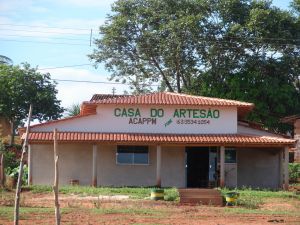
The latest data on employment in the region studied are from Sample Work and Income for the 2000 census, specifically information on persons 10 years or older, total economically active and occupied during the reference week by sex and status home, plus the information of people over10 years employed in the reference week section of the main work activity. The municipal data were compared with data for states and Brazil, to check how it behaves a local analysis in the face of more comprehensive data.
 In Brazil, the largest of 10 years, 56.58% is reported in the IBGE research as being economically active population (PEA), formally employed or not. This situation is repeated with little variation in the four states included in the study area, the largest discrepancy occurred in Maranhão, in the order of -5.9%. In turn, the verification of PEA in the cities is much more variable, with a range of values of 32.73% between the highest labor force in the municipality of Rio da Conceição (TO), with 63.48% of the population over 10 economically active years, and the lowest labor force in the municipality of Lagoa do Tocantins (TO) with 30.74%.
In Brazil, the largest of 10 years, 56.58% is reported in the IBGE research as being economically active population (PEA), formally employed or not. This situation is repeated with little variation in the four states included in the study area, the largest discrepancy occurred in Maranhão, in the order of -5.9%. In turn, the verification of PEA in the cities is much more variable, with a range of values of 32.73% between the highest labor force in the municipality of Rio da Conceição (TO), with 63.48% of the population over 10 economically active years, and the lowest labor force in the municipality of Lagoa do Tocantins (TO) with 30.74%.
Issues such as the location of the population (whether urban or rural) is not irrelevant to the municipalities studied, since what we see in them is not monitoring the state averages or the national average. In Brazil, the total labor force, 83.12% is urban, while in Tocantins state is closest to this value, with 78.53% of the urban labor force. In the cities it highlights the low levels of PEA in urban Rio Sono (TO), São Gonçalo do Gurguéia and Santa Filomena (PI), with respective 27,09%, 27,94% and 38,92%. On gender issues, there is not much to consider, since the states and municipalities follow closely what is found in Brazil as a whole (60,09% PEA is male), but with a slight predilection for the hand-labor male over female, on average, 5,83% more. It emphasizes a gender justice in São Félix doTocantins (TO), in order of 49,52% and male labor force.
Regarding the main job activities, the research shows that the sector that employs in Brazil are engaged in agriculture, livestock, silviculture and forest exploitation (agrosilvopastoris activities), which employs 17,94% of the national PEA, followed very closely by trade, with 16,61%. In the states studied agrosilvopastoris activities have a greater presence in employment activities, while the trade is fairly well approximates the national percentage.
Tocantins is a state that is closest to the national situation with regard to activity agrosilvopastoril, and then with an increase of over 10 percentage points. In turn, the state of Maranhão is the furthest with their 42,04% of the PEA involved with this activity. In some municipalities agrosilvopastoris activities account for more than 50% of jobs, such as the municipalities tocantinenses of Rio Sono (72,41% of total employment in these activities) and Lizarda (57,02%) and piauienses of São Gonçalo do Gurguéia (68%), Santa Filomena (58,67%) and Barreiras do Piauí (57,76%). About the trade sector, none of the municipalities is above the national data (16,61% of the PEA) and 12 of the 17 municipalities in the target area are involved with PEA Trade with percentages below half the national rate, with emphasis on the Lagoa do Tocantins , Rio Sono and São Félix do Tocantins (TO), with respective 2,01%, 2,56% and 3,16% of its labor force in trade.
Strong state and local discrepancy is seen in the professional practice in public administration, defense and social security. 5,37% of the Brazilian PEA is involved in this activity, while in the state of Tocantins is more than double the workforce active and in some municipalities tocantinenses, that comes to quadruple, as is the case of Rio da Conceição and Lagoa do Tocantins, with 26,53% and 22,11%, respectively, of the PEA directly employed by the government. Santa Tereza do Tocantins and São Félix do Tocantins have twice the national rate of 5,37%, with their respective 12,87% and 11.05%.
Education and domestic services are also relevant in the region. Education employs more than 10% of the PEA (double the national values and nearly double the state) in Lagoa do Tocantins, Mateiros, Ponte Alta do Tocantins and São Félix do Tocantins (TO).
In turn, domestic service is significant in Almas, Lagoa do Tocantins and São Félix do Tocantins, also involving more than 10% of the labor force in those municipalities. Other activities such as fishing, mining and quarrying, processing, production and distribution of electricity, gas and water, construction, transportation, storage and communication, housing, food, financial intermediation and real estate, renting and business services, health and social and collective, social and personal services, employment in international organizations and other extraterritorial institutions or poorly specified activities are not relevant in the municipalities. Only one caveat about the tourist potential of the region, that may be leveraged regionally through the integrated management of regional conservation units, since the traditional branches have failed to impose a more positive dynamic for the population economically active site.